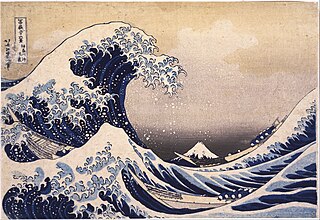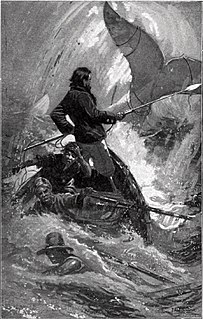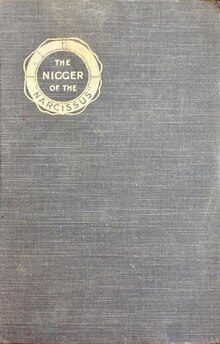
Joseph Conrad was a Polish-British writer regarded as one of the greatest novelists to write in the English language. Though he did not speak English fluently until his twenties, he was a master prose stylist who brought a non-English sensibility into English literature. Conrad wrote stories and novels, many with a nautical setting, that depict trials of the human spirit in the midst of what he saw as an impassive, inscrutable universe.

In Greek mythology, Narcissus was a hunter from Thespiae in Boeotia who was known for his beauty. According to Tzetzes, he was a Laconian hunter who loved everything beautiful. Narcissus was proud, in that he disdained those who loved him, causing some to take their own lives to prove their devotion to his striking beauty. Narcissus is the origin of the term narcissism, a fixation with oneself and one's physical appearance or public perception.
In the English language, the word nigger is an ethnic slur typically directed at black people, especially African Americans.

The Rime of the Ancient Mariner is the longest major poem by the English poet Samuel Taylor Coleridge, written in 1797–98 and published in 1798 in the first edition of Lyrical Ballads. Some modern editions use a revised version printed in 1817 that featured a gloss. Along with other poems in Lyrical Ballads, it is often considered a signal shift to modern poetry and the beginning of British Romantic literature.

Méduse was a 40-gun Pallas-class frigate of the French Navy, launched in 1810. She took part in the Napoleonic Wars during the late stages of the Mauritius campaign of 1809–1811 and in raids in the Caribbean.

The forecastle is the upper deck of a sailing ship forward of the foremast, or the forward part of a ship with the sailors' living quarters. Related to the latter meaning is the phrase "before the mast" which denotes anything related to ordinary sailors, as opposed to a ship's officers.

The Flying Dutchman is a legendary ghost ship which was said to never be able to make port, doomed to sail the oceans forever. The myth is likely to have originated from the 17th-century Golden Age of the Dutch East India Company (VOC) and Dutch maritime power. The oldest extant version of the legend has been dated to the late 18th century. According to the legend, if hailed by another ship, the crew of the Flying Dutchman was said to try to send messages to land, or to people long dead. Purported sightings in the 19th and 20th centuries claimed that the ship glowed with a ghostly light. In ocean lore, the sight of this phantom ship is a portent of doom.

Alan John Villiers DSC; Military Order of St James(23 September 1903 – 3 March 1982) was an author, adventurer, photographer and mariner.
Nigger is an ethnic slur typically directed at black people.
A chronological list of Joseph Conrad's works.

"Youth" is an 1898 autobiographical short story by Joseph Conrad published in Blackwood's Magazine, and then included as the first story in Conrad's 1902 volume Youth, a Narrative, and Two Other Stories. This volume also includes Heart of Darkness and The End of the Tether, stories concerned with the themes of maturity and old age, respectively. "Youth" depicts a young man's first journey to the East. It is narrated by Charles Marlow who is also the narrator of Lord Jim, Chance, and Heart of Darkness. The narrator's introduction suggests this is the first time, chronologically, the character Marlow appears in Conrad's works.

Expurgation, also known as bowdlerization, is a form of censorship which involves purging anything deemed noxious or offensive from an artistic work, or other type of writing of media.

Mayflower was an English ship that transported a group of English families known today as the Pilgrims from England to the New World in 1620. After a grueling 10 weeks at sea, the Mayflower, with 102 passengers and a crew of about 30, reached America, dropping anchor near the tip of Cape Cod, Massachusetts, on November 21 [O.S. November 11], 1620.
Simon Hatley was an English sailor involved in two hazardous privateering voyages to the South Pacific Ocean. On the second voyage, with his ship beset by storms south of Cape Horn, Hatley shot an albatross, an incident immortalised by Samuel Taylor Coleridge in his 1798 poem The Rime of the Ancient Mariner.

Torrens was a clipper designed to carry passengers and cargo between London and Port Adelaide, South Australia. She was the fastest ship to sail on that route, and the last sailing ship on which Joseph Conrad would serve before embarking on his writing career.
Sailors' superstitions have been superstitions particular to sailors or mariners, and which traditionally have been common around the world. Some of these beliefs are popular superstitions, while others are actually better described as traditions, stories, folklore, tropes, myths, or legend.
Joseph Conrad was a Polish author who wrote in English after settling in England. He is regarded as one of the greatest writers in English, though he did not speak the language fluently until he was in his twenties, and always with a marked Polish accent. Before embarking on his writing career, he had a career sailing in the French, then the British merchant marine; of his 19-year merchant-marine career, about half that time was spent actually at sea.

The role of the sea in culture has been important for centuries, as people experience the sea in contradictory ways: as powerful but serene, beautiful but dangerous. Human responses to the sea can be found in artforms including literature, art, poetry, film, theatre, and classical music. The earliest art representing boats is 40,000 years old. Since then, artists in different countries and cultures have depicted the sea. Symbolically, the sea has been perceived as a hostile environment populated by fantastic creatures: the Leviathan of the Bible, Isonade in Japanese mythology, and the kraken of late Norse mythology. In the works of the psychiatrist Carl Jung, the sea symbolises the personal and the collective unconscious in dream interpretation.

Nautical fiction, frequently also naval fiction, sea fiction, naval adventure fiction or maritime fiction, is a genre of literature with a setting on or near the sea, that focuses on the human relationship to the sea and sea voyages and highlights nautical culture in these environments. The settings of nautical fiction vary greatly, including merchant ships, liners, naval ships, fishing vessels, life boats, etc., along with sea ports and fishing villages. When describing nautical fiction, scholars most frequently refer to novels, novellas, and short stories, sometimes under the name of sea novels or sea stories. These works are sometimes adapted for the theatre, film and television.
This article treats usage of the word nigger in reference to African Americans and others of African or mixed African and other ethnic origin in the art of Western culture and the English language.














